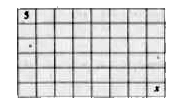mn squares of equal size are arranged to form a rectangle of dimension m by n, where m and n are natural numbers. Two square will be called neighbors if they have exactly one common side. A number is written in each square such that the number written in any square is the arithmetic mean of the numbers written in its neighboring squares. Show that this is possible only if all the numbers used are equal.
Step by step video & image solution for mn squares of equal size are arranged to form a rectangle of dimension m by n, where m and n are natural numbers. Two square will be called neighbors if they have exactly one common side. A number is written in each square such that the number written in any square is the arithmetic mean of the numbers written in its neighboring squares. Show that this is possible only if all the numbers used are equal. by Maths experts to help you in doubts & scoring excellent marks in Class 11 exams.
Updated on:21/07/2023Similar Questions
Knowledge Check
The arithmetic mean of the squares of first n natural numbers is
An+16B(n+1)(2n+1)6Cn2−16Dnone of theseWhat is the arithmetic mean of the squares of first five natural numbers?
A9B11C13D15The arithmetic mean of two numbers is 1834 and the positive square root of their product is 15. The larger of the two numbers is
A24B25C20D30
Derive the formula for finding the mean of square of n natural number
View SolutionThe ratio of the number of sides of a square to the number of edges of a cube is
View SolutionIn Fig. 8.3 each square is filled with the arithmetic mean of the numbers in the boxes sharing a side with it. If the first square is filled with 5, then value of x is

View SolutionThe number, whose square is equal to the difference of the squares of the numbers 68 and 32, is
View SolutionThe ratio of the number of sides of a square to the number of sides of a triangle is
View Solution
